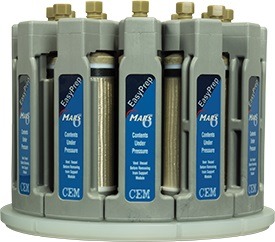
The iWave™ contactless in-situ temperature sensor, developed by CEM, uses light emitting technology (LET) to save time and money, while improving accuracy, on their MARS 6 microwave digestion system, the company claims.
Light emitting technology (LET) is a method that utilises the emission of light from a sample solution to rapidly and accurately measure the temperature of that solution. CEM have used this principal to develop their iWave™ proprietary technology, which has now been applied to their MARS 6 microwave digestion system. Unlike fibre optic probes, which has been the default technology for the last 25 years,
LET measures the temperature of the solution itself, not the vessel containing the liquid. This makes the iWave™ a more accurate temperature sensor while also negating the need for a control vessel.
In the MARS 6 microwave digestion system CEM have floor- mounted the iWave™ sensors in the cavity of the instrument and ever time a vessel rotates past a sensor a measurement is made. As this measurement is occurring in real time MARS 6 software can automatically adjust the power to each separate vessel, helping to ensure a successful digestion, while improving safety through the monitoring of sudden temperature changes.
Given their function, immersed probes in particular are prone to damage through acid and heat, and removing the need for them from a system means an immediate saving in replacement costs as well as preventing break down problems. Temperature probes can also be difficult to set up, so the use of contactless iWave™ technology also means a saving in time, increasing sample throughput and saving on labour costs.
Thinking ahead again, CEM have also designed their iWave™ sensors for the MARS 6 to be completely field upgradable, thus ensuring that their large customer base is fully able to take advantage of this innovative technology.
To find out about the iWave please click here.






